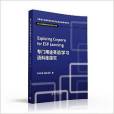內容簡介
本書作者Laura Gavioli是
莫德納和勒佐艾米利亞大學的教授,多年來致力於語料庫在語言教學、翻譯教學和專門用途英語教學中的套用方面的研究。本書探究了基於語料庫的學習方式對ESP教學中二語習得的影響,全書共分七章:引言、語料庫語言學和語言教學的背景概況、理論前提、語料庫和專門用途英語的關係、教師如何指導學習者研究語料庫和數據、學習者探索語料庫的過程和語言產出結果,以及結論。本書內容聚焦語料庫語言學和專門用途語言的結合點,探討了
數據驅動學習的理論前提,探索了學生自主學習的方法和可行性。結果表明,在教學中使用語料庫數據分析的方法,可以引發有關語料庫語言學從理論和實踐兩個角度對教學的意義進行討論和反思。
本書對於語料庫語言學和專門用途語言教學的教材設計者、套用語言學家、教師和學習者都具有很強的理論和實踐指導意義。
目錄
Table of contents
Acknowledgments ix
Key to abbreviations and acronyms xi
A note for the reader xi
CHAPTER 1
Introduction 1
1.1 Why this book? 1
1.2 Corpora and "models" of language 3
1.3 Why ESP settings? 5
1.4 The corpora in this book 6
1.4.1 Small corpora and specialized corpora 6
1.4.2 Description of the corpora used here.
1.5 A word about concordances and concordancing tools 1t
1.6 Which learners? 12
1.7 How the book is organized 13
CHAPTER 2
Corpus linguistics and language teaching and learning: A background 17
2.1 Language corpora in language pedagogy: The 90s debate 17
2.1.1 Critical viewpoints 17
2.1.2 The contribution of corpus analysis to language pedagogy 20
2.2 Corpus analysis as a tool for language teachers 22
2.2.1 Corpus analysis and syllabus design 23
2.2.2 Supporting teachers explanations 25
2.3 Corpus analysis as a tool for language learners 27
2.3.1 The Data-Drivrn Learning approach 27
2.3.2 Question一:Should the teacher guide the learners? 29
2.3.3 Question 2: Learners or researchers? 30
2.3.4 Question 3:Is the result worth the effort? 32
2.4 Conclusion 33
CHAPTER 3
Theoretical premises for teachers and learners 35
3.0 Introduction 35
3.t Learners looking at concordance data: What do they see? 36
3.2 Language as idiom vs. language as a logical system 41
3.3 The contribution of corpus work to a "new" idea
of language compositionality 42
3.3.1 The open-choice principle and the idiom principle 43
3.3.2 The search for units of meaning 44
3.3.3 Unusuali丫and creativity 47
3.4 Learners, "idioms" and corpus work 49
3.5 Conclusion 50
CHAPTER 4
Corpus work, ESP and language learners 53
4.0 Introduction: From small to specialized corpora 53
4.t ESP and specialised corpora: A happy marriage 55
4.1.1 ESP, quantitative data and corpus analysis:
A natural development 55
4.1.2 ESP and corpus work 56
4.2 Specialised language and specialized teaching purposes 60
4.3 The continuum between specialized and general corpora 63
4.3.1 Register variation across genres句
4.3.2 Identifying specificity 65
4.4 Specialized language corpora and language learning 67
4.5 Conclusion 69
CHAPTER 5
Guiding the learners to work with corpora and corpus data 71
5.0 Introduction 71
5.1 Type of material: Samples vs. examples 72
5.1.1 Task I: Looking at the concordance lines as samples 74
5.2 "What to look for" in a concordance: Recurrence and typicality 76
5.2.1 Task 2: Focusing the students' attention
on recurrent patterns 79
5.3 Correlating output data and corpus texts 81
5.3.1 Task 3: Corpus data and corpus content 82
5.3.2 Follow-up of Task 3: Leading students to create corpora 84
5.4 Conclusion 85
CHAPTER 6
Learners exploring corpora to observe and produce texts:
Spies in action 87
6.o Introduction 87
6.1 Corpora and ESP learners: "Spies" 88
6.2 Using a small corpus of specialized texts to discover
technical concepts go
6.2.1 A medical word: The case of the acronym "RIBA" 91
6.2.2 A word from economics: The case of"bid" 94
6.2.3 Conclusion 98
6.3 From a single corpus to more corpora:
Comparing data 99
6.3.1 How specialized is a specialized word?
The case of the word disorder.100
6.3.2 Exploring corpora in different languages:
Contrasting English and Italian data 104
6.4 Interacting with "the authorities":
Completing or contrasting explanations from reference
materials and the teacher 109
6.4.1 The case of the progressive tense in medical
research articles 110
6.5 Exploring corpora to produce texts 113
6.5.1 Translating a medical abstract 114
6.5.2 Writing out apolitical speech 118
6.6 Conclusion: From spies to "double-agents"? 123
CHAPTER 7
Concluding remarks 127
7.1 Three answers? 127
7.1.1 If learners are to behave as data analysts, what should be
the role of the teacher? 127
7.1.2 Learners or researchers? 129
7.1.3 Is the effort a worthwhile one? 131
7.a Corpus work and pedagogy: Old or new questions? 133
7.3 Future developments 134
7.3.1 Tools and teaching materials 135
7.3.2 Corpus-based dictionaries and learners 136
7.3.3 Corpus work and teachin州learning skills 137
7.3.4 Serendipity 138
7.3.5 Understanding deviance139
7.3.6 Recurrence, deviance and language awareness 141
7.4 A concluding wish 142
APPENDIX 1 145
APPENDIX 2 147
APPENDIX 3 153
APPENDIX 4 157

